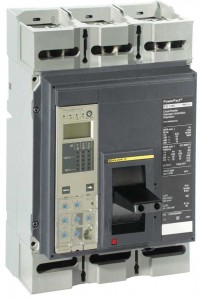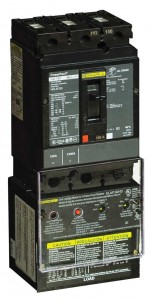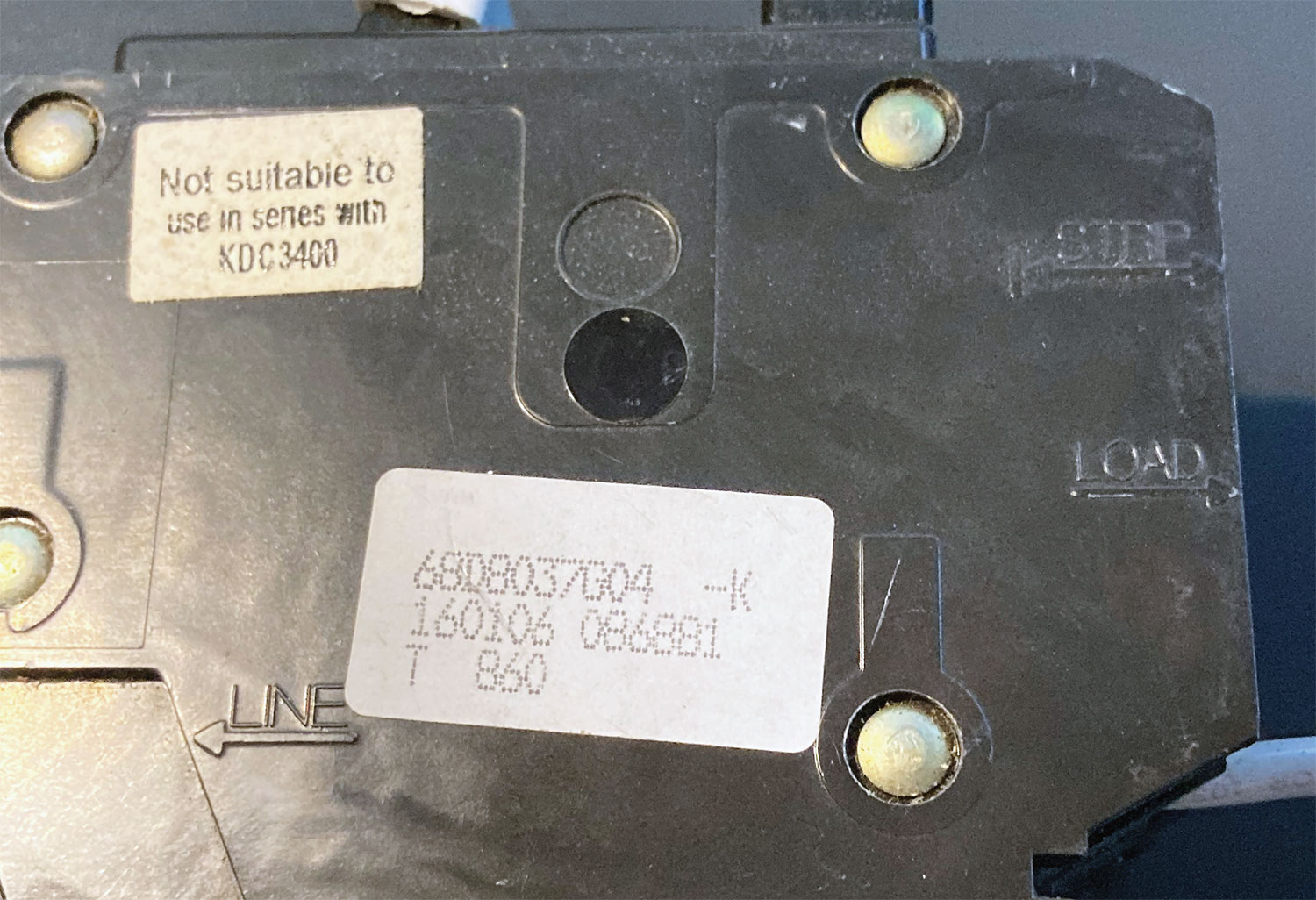The wording of the exception may introduce confusion as it states that the ground-fault protection device “shall be identified…for backfeeding,” which implies a specific marking on a circuit breaker equipped with GFPE. In actuality it is the absence of “line” and “load” markings on a circuit breaker that indicates that it is suitable for backfeeding.
The Fine Print Note in 690.64(B)(5) adds clarity, stating that:
(5) Suitable for Backfeed. Circuit breakers, if backfed, shall be suitable for such operation.
FPN: Circuit breakers that are marked “Line” and “Load” have been evaluated only in the direction marked. Circuit breakers without “Line” and “Load” have been evaluated in both directions.
Similar wording can be found in Article 705, Interconnected Electric Power Production Sources.
705.12 Point of Connection.
(D) Utility-Interactive Inverters.
(3) Ground-Fault Protection.The interconnection point shall be on the line side of all ground-fault protection equipment.
Exception: Connection shall be permitted to be made to the load side of ground-fault protection, provided that there is ground-fault protection for equipment from all ground-fault current sources. Ground-fault protection devices used with supplies connected to the load-side terminals shall be identified and listed as suitable for backfeeding.
(5) Suitable for Backfeed.Circuit breakers, if backfed, shall be suitable for such operation.
FPN: Circuit breakers that are marked “Line” and “Load” have been evaluated only in the direction marked. Circuit breakers without “Line” and “Load” have been evaluated in both directions.
In the 2011 National Electrical Code, Section 690.64 has been changed to simply refer to Section 705.12. No changes have been made to 705.12(D)(3) or (5).

Can Standard Circuit Breakers be Backfed?
UL White Book
Molded-case circuit breakers are referenced under category DIVQ in the UL White Book. Under Installation, the White Book states that, “Line and load markings on a circuit breaker are intended to limit connections thereto as marked.” The White Book also contains a copy of the Molded-Case Circuit Breaker Marking Guide, which states in part:
5. Line and Load Identification —A circuit breaker may or may not be marked “Line” and “Load.” If it does not have this marking, it is acceptable for reverse connection…
Can Circuit Breakers with GFPE be Backfed?
The answer to this question depends on how the ground-fault protection function is powered. The electronic circuitry used to provide the ground-fault protection may be either line-powered or fault-powered.
Miniature circuit breakers (MCBs) of the type typically used in residential and “lighting panelboard” applications may be equipped with GFPE, often with a nominal 30 mA trip level, for protection of heating cables and other applications. Because of the low ground-fault trip level of these circuit breakers, their electronic circuitry must be line-powered.
MCBs equipped with GFPE are distinctive in that they have a white “pigtail” wire intended for connection to the neutral bar in the panelboard in which they are installed (see figure 1). Connecting the pigtail wire serves two functions. First, because the branch circuit neutral wire, also called the grounded conductor, must be connected to the circuit breaker rather than to the neutral bar, it completes the branch circuit. Second, it also completes the power supply circuit for the electronic ground-fault detection circuitry.

Figure 3. 150-A frame thermal-magnetic circuit breaker with add-on earth leakage module
When correctly connected, a ground-fault will result in the circuit breaker contact(s) opening, cutting power to the trip solenoid. If the circuit breaker is backfed, power to the trip solenoid will not be cut when the circuit breaker contact(s) open, resulting in damage to the trip solenoid, which is not rated for continuous duty. For this reason the terminals on these circuit breakers are identified with “line” and “load” markings.
What about Larger Circuit Breakers with GFPE?
The GFPE function is fault-powered in larger molded-case, insulated-case, and low-voltage power circuit breakers that have a typical nominal ground-fault pick-up range between 200 and 1200 A (see figure 2). This means that the current transformers within these circuit breakers supply power to the electronic circuitry in addition to measuring the current flowing in the circuit. The trip solenoid in these circuit breakers cannot be damaged due to backfeeding because as the circuit breaker’s contacts are opened, power to the trip solenoid is also removed; therefore, these circuit breakers do not have “line” and “load” markings.
Large molded-case, insulated-case and low-voltage power circuit breakers with GFPE, when used as a main circuit breaker, are often backfed in applications where the incoming power that feeds the equipment is supplied through the floor (bottom fed equipment). In addition, these circuit breakers are also suitable for backfeeding when used as tie circuit breakers in multiple source applications such as double ended equipment.
What about Add-On Modules?
Some manufacturers offer add-on GFPE modules for their lower amp frame thermal-magnetic molded-case circuit breakers. These modules are typically fault-powered, in which case they may be backfed.
Add-on “earth-leakage” modules for lower amp frame thermal-magnetic molded-case circuit breakers providing low level GFPE are also offered by some manufacturers. These modules are not suitable for backfeeding as they are line-powered devices. The OFF end terminals on these modules are marked “load” (see figure 3).
The circuit breakers are not marked “line” and “load,” however, the add-on modules are marked “load” on the end with the lugs. The earth-leakage module shown in figure 3 may only be connected to the OFF end of a circuit breaker.
What about Ground-Fault Circuit Interrupters?
MCBs may also be equipped with ground-fault protection for personnel, in which case they are called ground-fault circuit interrupter (GFCI) circuit breakers. GFCIs have a nominal 5 mA ground-fault trip level. Once again, because of the low ground-fault trip level of these circuit breakers, their electronic circuitry must be line-powered. Similar to MCBs equipped with GFPE, these circuit breakers also have a distinctive white “pigtail” wire intended for connection to the panelboard neutral bar. Like MCBs with GFPE, they will be damaged under a ground-fault condition if they are backfed. For this reason the terminals on these circuit breakers are also marked “line” and “load.”
What about GFPE That Is Not a Circuit Breaker?
This is equipment that is only covered by the UL Standard for Ground Fault Sensing and Relaying Equipment, UL 1053, and has not been investigated for compliance with the UL 489 standard for molded-case circuit breakers. Testing under UL 1053 is conducted with the device connected in accordance with the manufacturer’s instructions. Equipment covered under this category is suitable for backfeeding when marked as such.
The UL Guide Information for the category Ground Fault Sensing and Relaying Equipment, KDAX, includes the statement : Ground-fault sensing and relaying equipment not additionally covered under DIVQ has not been investigated for operation with a supply source connected to the load-side terminals unless identified as suitable for backfeeding.
Summary: How Do I Determine Suitability and Code-Compliance?
Circuit breakers with line-powered ground-fault protection, such as those with a pigtail connection, are not suitable for backfeeding. The terminals on these circuit breakers are identified with “line” and “load” markings.
Circuit breakers with fault-powered ground-fault protection such as larger molded-case, insulated-case and low-voltage power circuit breakers, or smaller thermal-magnetic circuit breakers with add-on ground-fault modules, are not marked “line” and “load” and thus are suitable for backfeeding.
Add-on earth leakage modules for smaller thermal-magnetic circuit breakers are line-powered and are not suitable for backfeeding. The wire terminal end of these modules is marked “load.”
The markings, or lack of markings, on the circuit breaker or add-on module, the manufacturer’s application information and the instructions provided with the product will clearly indicate whether or not it is suitable for backfeeding in accordance with its listing. This applies to all applications, including PV and other utility-interactive systems. When in doubt, contact the circuit breaker manufacturer.
Ed Larsen
Bob LaRocca
Jeff Hidaka










Find Us on Socials